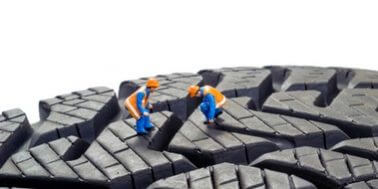Regularly checking your tyre tread is vitally important to ensure that you comply with the legal requirements and you can continue to drive safely on the road.
Your tyre tread is your only means of contact with the road. If your tyre tread is worn, it might put you and other road users in danger, and you could face serious legal consequences.
Tyre tread legal requirements
For cars, the legal minimum tyre tread is 1.6mm. New car tyres start with approximately 8mm of thread. We recommend changing your tyres when you tread wears down to 3mm.
If one of your tyres is worn below the legal limit, you face the risk of a £2,500 fine and three penalty points. If all four tyres are worn below the legal limit, you’re looking at a £10,000 fine and potentially losing your licence.
Tyre tread safety
If your tyres don’t have sufficient tread, it may affect your safety on the road. Your risks could include:
- Increased stopping distance: Say your car is travelling at 50mph on a rainy day. With the legal minimum tyre tread of 1.6mm, your car can brake to a halt in 39.5 metres. With only 0.8mm tyre tread, this increases to 53.1 metres.
- Aquaplaning: If your tyre tread is worn down, when driving wet conditions, a layer of water builds up between your tyres and the surface of the road. Your tyres will lose their grip. You will lose control of your car and be unable to steer, brake or accelerate.
- Poor grip on snow and ice: Most tyres have small grooves called sipes. When your tyres make contact with the road the sipes expand to create traction. If your tyre tread is worn down, this traction is lost, which will give you poor grip when driving in snow and ice.
- Increased risk of a blowout: Your tyre tread gives protection to your tire casing, safeguarding your tyre from sharp objects that can puncture your tyre such as nails or glass. Without this protection, you risk a blowout of your tyre, causing loss of control.
- Air leaking: Tyres with worn tyres are more prone to air leaking. The loss of air causes your tyre pressure to drop which will impair steering and braking, as well as increase the rate of tyre wear.
How to check your tyre tread
You can check your tyre treads by looking at your treadwear indicators. These indicators are small raised areas placed inside your tyre tread grooves. Once the surface of your tyre tread is worn down to the level of the treadwear indicator, your tyre tread depth has reached the legal limit of 1.6mm.
The ‘20p test’ is another quick and simple way to check your tyre treads. Just take a 20p coin and slot it into your tyre tread groove. If the outer band of the 20p coin is not visible and sitting inside the groove, your tyre tread is above the legal limit. But if the outer band of the coin is visible, your tyre tread has worn down to the point where it may have exceeded the legal limit.
If it looks like your tyre tread has worn down and is close to the legal limit, the next thing to do is to have your tyres professionally checked and replaced.
Need to check your tyre treads? Bring your car to Double Dee Autos and our team will get you sorted. Call us anytime on 020 8460 3040 to book an appointment.

